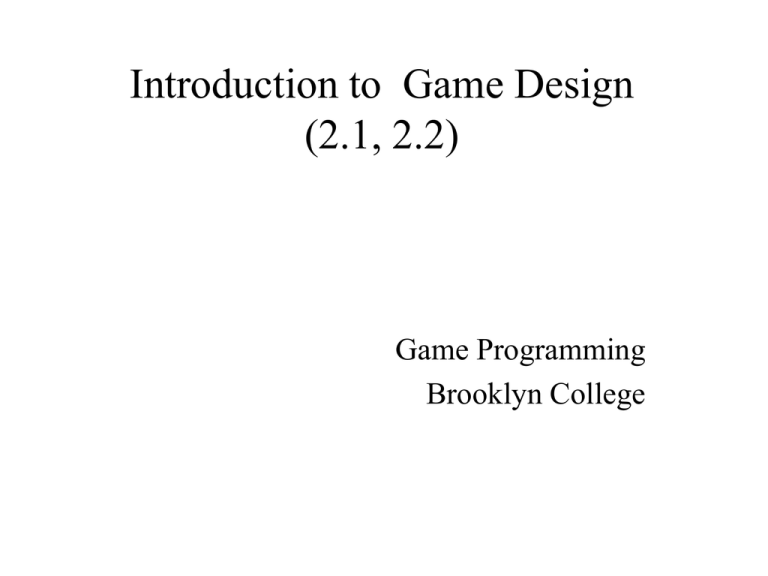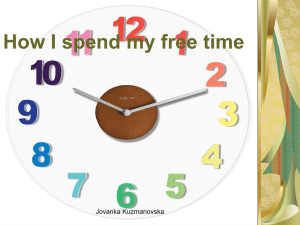Game Theory
advertisement

Introduction to Game Design (2.1, 2.2) Game Programming Brooklyn College Reality Check • We have so far covered – History of video games – Games and Society • Each of those topics could be a whole class. • Game Design as a topic, could be several classes (and is several classes at many schools). Serious about game design? • Fundamentals of Game Design, 2nd Edition, by Ernest Adams, New Riders • Rules of Play: Game Design Fundamentals, by Katie Salen and Eric Zimmerman, MIT Press. Contents – Questions, questions – Game Studies vs. Game Theory • Psychology, Dynamics, Mechanics • "Funativity" – – – – – Abstract Rules Concrete Rules Narrative Genres What's your idea? Questions 1. 2. 3. 4. 5. 6. What's your favorite video game? (now, ever) What made/makes that game fun? Does a game have to be fun? What is fun? What is a game? Can a video game be "art"? questions • With so much money at stake, thousands of papers and books have been written on the subject of game design/development. • We would like to answer the following questions: – What defines (how do we classify) a game? – What makes a game fun? – Can we come up with a methodology for creating successful games? Game Studies != Game Theory • Don't confuse "game studies" with "game theory". They are not the same thing. • Game studies: The discipline of studying games; in particular their design, their players and the role they play in society. • Game Theory: A mathematical method of decision-making in which a competitive situation (could be a game) is analyzed to determine the optimal course of action for an interested party (agent). Game theory is often used in politics, economics and military planning. • Note: We also use Game Theory when contemplating "agents" within a game. Game Studies • Game studies is a "huge" field. – Psychology, Sociology view • The effects of games on people (and vice versa) • "What makes games fun?" – Structure, Dynamics view • games as artifacts, "affordances", critical analysis • "How do you define a game and it's rules?" – Industry/Engineering view • design and development of games, how to make better games, games as drivers of technological innovations • "Can we come up with a method to make great games?" "Funativity" (psychology/sociology) • How, why is something fun? • Do these kittens look like they are having fun? "Theory of Natural Funativity" • All fun derives from practicing skills that (previously) insured species survival. • Skills may relate to earlier context, but appear disguised in a more modern form. • Games are safe way to "practice" skills. • Applied to Cats: Adult cats need to be able to catch small prey for food and fight for territory/mates. – Thus kittens practice: • Hunting -> Chasing feather, ball of string, tail • Fighting -> Attacking each other, ball of string, your leg. Funativity & Humans • For most of our species’ history humans have been tribal hunter/gatherers. • Many current popular games reflect modern incarnations of these ancient skills: – Hunting: • Shooters, sports games, hand-eye-coordination – Gathering: • Pattern games, powerups, resources – Tribal Interaction: • High scores, head-to-head, Sims, MMO Funativity & Humans (cont) – In humans we can identify three overlapping categories into which we can divide aspects of game play. – People like (or find fun) games that have components that fall into these categories (realms): 1. Spatial Reasoning (Physical) 2. Pattern Recognition (Mental) 3. Social 1. Spatial Reasoning (Physical) • Abstract Definition: Reasoning about objects in 3D space and how they might interact (includes your own body, hand-eye coordination). • Note: Preferred by boys. 2. Pattern Recognition (Mental) • Abstract Definition: Recognizing patterns in organized sets of data, remembering chains of linked events that are significant. • Note: Preferred by girls. 3. Social • Abstract Definition: Practicing interpersonal communication skills, competing/cooperating with others or modeling dynamics of social situations. Other "psychological" aspects. • Suspension of disbelief (immersion). – A game isn't "real", and yet we can have "real" physical/psychological responses (anger, fear, pride). – "Immersive" and "flowing" gameplay. • Emotions and feelings. – We are more likely to play a game, if it can make us "feel" an emotion (change our internal state). – Anxiety and frustration are bad, but... – Indifference is the ultimate enemy. The concept of "Flow" • “Flow: The Psychology of Optimal Experience” by Csikszentmihalyi – Flow is a state of exhilaration, deep sense of enjoyment. – Keeps player immersed in the gameplay. • Start with relatively low level of challenge to match starting skill levels. Then gradually increase challenge. – Fast enough to prevent boredom – Not so fast as to induce frustration What is a game? (structure/dynamics) • Not a simple question. • Things we find in (some) games: – – – – – Objectives, goals Outcomes, (specifically variable results) Uncertainty Rules and Structure Stories • A game as a "magic circle". Ludology (structure/dynamics) • From the Latin ludus (game) + -logy. The study of games and other forms of play. • Ludologists analysis games in terms of the abstract and formal systems that the games describe. • In other words, the focus of ludologists are on "the rules of a game". Narratology (structure/dynamics) • Ludology has a competing view that is called "narratology". • The narratological view is that games should be understood as novel forms of storytelling and can thus be studied using theories of narrative. • "Choose your own adventure?" • (Question: What is the compelling story behind "tetris"?) Concrete Components (structure/dynamics) • Research has identified many concrete things that can improve a players perception of a game: 1. Multiple clear achievable goals. 2. The illusion of choice. 3. Clear punishments and rewards. 1. Goals (multiple, clear, achievable) • We are a goal-drive species and find psychological reward in completing objectives. • If it takes too long to achieve a goal, player may get bored, so, create many simultaneous goals. • Player should always have at least one clear objective. • One "unbeatable" boss or board, one "impossible" jump or goal can ruin a game. 2. Choice (or at least the illusion) • Players want to think that their decisions matter. – If you don't have choice, game is just a complicated slide presentation. • Different choices or actions sequences that results in identical results will frustrate players. – Complaints about "linear" gameplay. • Character customization, alternate endings, good vs. evil dynamics. • "Game is a series of interesting choices" - Meier A convexity of choices • Starts with a single choice, widens to many choices, returns to a single choice B B A B A A B A A 3. Rewards and Punishments • Value of an item (to an individual) closely correlates with what it cost to acquire (money, time, effort). • A player who has spent time and effort on completing a task, expects to be rewarded. • Likewise a player who has failed in an objective, expects to be punished. • If actions don't have consequences, then the game-play is meaningless. 3. Beyond Rewards and Punishments "The Skinner Box" • Some researchers suggest that modern game design is moving beyond "funativity" and moving towards direct conditioning of players aimed at getting them to play all the time (game addiction). • (15 minute reward loop) • Random rewards • Punishment for not playing. http://www.gamasutra.com/view/feature/3085/behavioral_game_design.php Narrative (structure/dynamics) • Questions: – What about the story? – Shouldn't a game have a good story? • The narratological view of game studies says that games should be understood as a form of storytelling. • Treating a game as a narrative (or including narrative as part of a game) can help us make a more compelling game, and may even be thought of as adding a "social" component. Narrative in Literature • Rules for narrative in literature have been around since the time of the Greeks (Aristotle's Poetics). • Questions to ask: 1. 2. 3. 4. Whose telling the story? What is the conflict? Who is the player meant to identify with? What do you want the player to feel? Narrative in Film • Modern games have far more in common with film (cinematography) then with regular literature. Cinema also has a lexicon of well established rules regarding the creation of compelling narrative. 1. Don't break the narrative plane. 2. Don't break the narrative chain. 3. Use the camera to frame action. 4. Use the camera to immerse the viewer. – (Note: What's unique about games is that you always have perfect camera, light, etc.) Narrative in Games • Ultimate goal (as with literature, and cinema) is to get the player or viewer to "suspend disbelief" and have a "real" emotional response to events that are entirely fictitious. • Including a compelling narrative in a game can "make it incredible" (ChronoTrigger, BioShock) or simply create a series of annoying cut scenes that a player has to wade through. Narrative in Games (cont) • It’s All About Interactivity! • “Do, don’t show” – let players experience story through interaction • Make it personal by having players make key choices, events affect them • Blend storytelling with design early • Use experienced interactive writers • Keep cut scenes BRUTALLY short. • Break up non-interactive sequences by adding interactivity, even if very simple Interface Design (Industry & Engineering) • Affordances: quality of an object, or an environment, that allows an individual to perform an action. • Keep interface simple (add shortcuts for advanced gameplay). • Provide feedback for EVERY action. • Design for error and special needs. So what makes a game fun? • Applying "natural theory of funativity": – Spatial Reasoning – Pattern Recognition – Social Interaction • Applying Concrete Rules: – Multiple clear achievable goals. – The illusion of choice. – Clear punishments and rewards. • Many great games have all of these components. Are there other rules... yes. A methodology for creating successful games? • Q: Knowing what we know now, can we create a formula or a pattern for creating great game. • A: No. Many useful game design methodologies have been suggested (MDA), and they do help insure that a game gets developed consistently and within time and budget limitations. • But every great game starts with a great idea, and nobody can predict where those come from. MDA Mechanics, Dynamics & Aesthetics • MDA is a game development paradigm designed to help developers make the most out of a game idea, and proceed efficiently through the complex process of bringing a game to market. • MDA is one of many development paradigms that are used by large game development companies. Mechanics • Before a single line of code is written the mechanics that will be used by the game should be well thought out and documented. • This includes: – – – – – – The programming language The programming libraries, engines, tools The hardware required/available The logical programming components The storage/retrieval/initialization methods The interfaces (software and hardware) supported Dynamics • Before a single line of code is written the dynamics that will be used by the game should be well thought out and documented. This is the "ludological" and part of MDA. All objects and axioms need to be detailed! • This includes: – – – – The domain of the game. The players in the game. The rules of the game. The objects in the game. Aesthetics • Before a single line of code is written the aesthetics that will be used by the game should be well thought out and documented. This is the "narratological" part of MDA. • The "art bible" which should contain every detail of the "look" of the game will come out of this development area. • This includes: – Color Palette – Physical looks for all players – Lighting plots, schemes, etc. MDA (2) • The Aesthetics can be broken up into more distinct components; ‘Eight Forms of Fun ’: – – – – – – – – • Sensation, game as sensory pleasure Fantasy, game as make-believe Narrative, game as drama Challenge, game as obstacle course Fellowship, game as social framework Discovery, game as uncharted territory Expression, game as self-discovery Submission, game as pastime. MDA’s goal is to provide a framework to span between game design, development, game criticism and research Genres • MDA also gives us a way to classify (and group) games into Genres: • Mechanical Genres: – IPhone game, C++ game, Quake Engine • Dynamic Genres – Shooter, Strategy, RPG, MMORPG • Aesthetic Genres: – Fantasy, Sci-Fi, Horror Survival Genres • Adventure – Sub-genres include text-based adventure and graphical adventure – Zork by Infocom – King’s Quest by Sierra • Action – Superset of all other action-oriented genres – Typified by fast-paced combat and movement – Spacewar, Pong, and Space Invaders helped define the genre 43 Genres • Action-Adventure – Adventure games with action elements – The Legend of Zelda was first break-out hit – Jak 3, Metroid Prime 2 Echoes, and Resident Evil 4 are modern examples of the genre • Platformer – Typified by a character running and jumping in a sidescrolling playing field – Modern definition has expanded to include 3D – Super Mario Bros., Sonic the Hedgehog, Pitfall! and Super Mario 64 are examples 44 Genres • Fighting – Players typically fight other players or the computer using swordplay or martial arts – Double Dragon is an example of a side-scrolling fighter – Virtua Fighter, Mortal Kombat, and Street Fighter. • First-Person Shooter – Action game where player is “behind the eyes” of the game character in a first-person perspective – id Software’s Wolfenstein 3D and DOOM are the earliest popular examples 45 Genres • Real-Time Strategy (RTS) – Typically, a game in which the goal is to collect resources, build army, and fight other player/AI. – Popularized by Westwood’s Dune 2 and Command and Conquer and Blizzard’s Warcraft • Turn-Based Strategy – Like real-time strategy games, but turn-based – Civilization, X-COM, Master of Orion, and Jagged Alliance are standouts of the genre 46 Genres • Role-Playing Game (RPG) – The video game counterpart to pen and pencil games like Dungeons and Dragons – Final Fantasy, Baldur’s Gate and Wasteland are some popular examples of the genre • Massively Multiplayer Role-Playing Game (MMORPG) – An RPG set in a persistent virtual world populated by thousands of other players – Ultima Online in 1997 was the first popular one – World of Warcraft is currently the most popular one 47 Genres • Stealth – Characterized by a focus on subterfuge and plannedout, deliberate play – Metal Gear in 1987 was one the first – Popular modern series include Metal Gear, Splinter Cell, and Thief • Survival Horror – An action-adventure or first-person shooter where survival elements and fighting undead are stressed – Resident Evil is easily the most popular series in this genre 48 Genres • Simulation – Based on the simulation of a system – SimCity and The Sims are example of “God” simulations where you control the lives many. – Wing Commander and X-Wing are popular space combat simulation games • Racing – Games that involve competing in a race in a vehicle – Typically try to re-create a real-world activity – Pole Position was first popular racing game 49 Genres • Sports – Games that simulate the sporting experience – Breakouts include John Madden Football and Tiger Woods’ Golf • Rhythm – Gauge player’s success based on the ability to trigger the controls in time to the beat of music – Sometimes require specialized controllers such as dance pads or bongo drums – Rock Band, Guitar Hero 50 Genres • Puzzle – Games that combine pattern matching, logic, strategy and luck with a timed element – Tetris is the breakout hit of this genre • Mini-Games – Short, simple games that exist within the context of a larger game – Mario Party and Wario Ware are popular examples of this genre – FABLE II, Pub games 51 Genres • Traditional – Computerized versions of board, word, and card games – Battle Chess and Hoyle series are standouts • Educational – Games designed to teach grade-school concepts to children and young adults – Oregon Trail was the first popular game in this genre – The Carmen Sandiego series and Mavis Beacon Teaches Typing are more modern popular examples 52 Genres • Serious – A game designed to teach real-world events or processes to adults – Most are privately funded – Popular with the US Government and the medical field • "Sapphire" simulation trainer 53 What's your idea? • Remember, there is no proven method for creating a great game. – Every great game started out as someone's great idea. – We have no proven way of generating great ideas. • IF you have a great idea, there are things you can do and methods you can apply to make it into the best game possible: – – – – Apply "theory of funativity" (Spatial, Mental, Social) Apply concrete rules (goals, choices, punishments & rewards) Include a compelling narrative (what should player feel?) Use a methodology such as MDA (Mechanics, Dynamics and Aesthetics) The End








